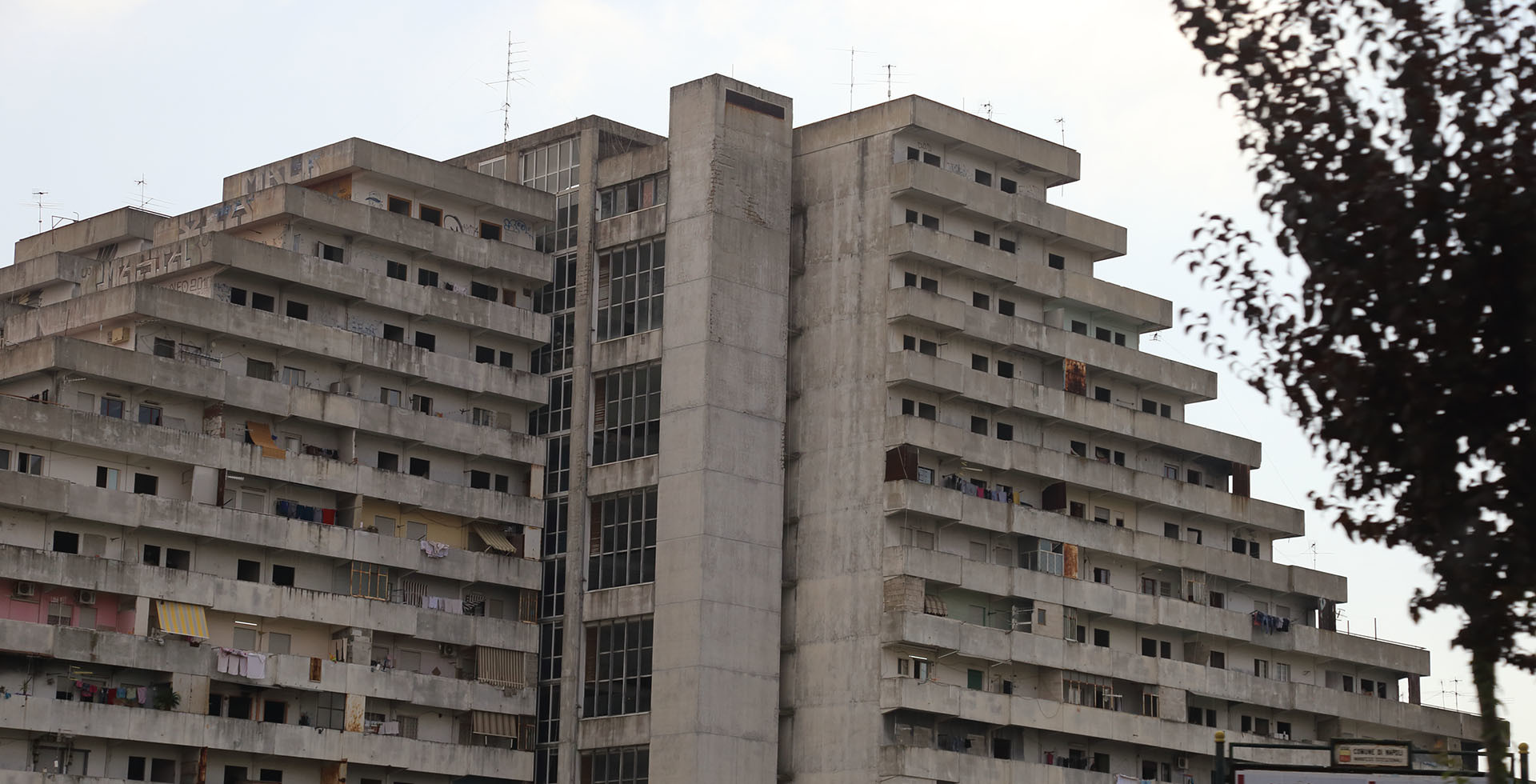Author | M. Martínez EuklidiadasCan architecture socially destabilize an entire neighborhood? Does the shape of buildings play a role in the presence of organized crime? The Sails of Scampia (Vele di Scampia, in Italian) are an example of how architecture can influence the behavior of citizens, or at least, how it can be used for unlawful purposes quite successfully.During the 80s the Camorra criminal organization managed to establish itself in the Sails of Scampia, then a newly created neighborhood in Naples. An architectural project, which ironically came about to improve the urban conditions of public housing and therefore foster the inclusion of vulnerable groups. Today we know that, fortunately, there are inclusive urban developments that have been implemented much more effectively.
The case of the Sails of Scampia
In around 1960, Naples had a serious poverty problem. Located in the southern region of Italy, a region that suffered the effects of a prolonged depression throughout the entire 19th, 20th and, at the moment, the 21st century. Despite its vast artistic heritage, the region’s desperate financial straits were widespread.Naples needed an urgent urban planning reform, which was undertaken by the architect and urban planning expert, Franz Di Salvo. Based on new state laws, Di Salvo designed a truly modern housing complex.From 1963 to 1975, the years in which the Sails were built, the project seemed to be going well. Hundreds of homeless families were relocated in these buildings. There were fewer poor people on the streets of Naples and, finally, state subsidized housing was provided for people in need.The project was portrayed internationally as a success, but behind the social urban planning and good intentions, corruption was rife. The structure was based on an illusion made up of briberies. The foundations were not solid and organized crime took advantage of every crack.
Why did this urban development project fail?
No urban planning failure is the result of just a single factor, and the Sails of Scampia are no exception. Numerous circumstances converged (government, urban planning, design and social circumstances), which converted the area into a ticking time bomb.
A poor application of law 167
In 1962, a few years before the buildings were constructed, an urban planning reform was approved in Italy by Fiorentino Sullo. Law 167 was set to become one of the best urban planning policies in terms of social integration, however, exactly the opposite occurred. Today we know why, but back then it was not so obvious.Instead of constructing new buildings and combining people in them from different educational backgrounds, different income ranges or nationalities, the Naples city council concentrated thousands of low-income, poor or extremely poor families in these buildings. These subsidized housing projects became a breeding ground for crime.
Misappropriation and occupation after the earthquake
Although the buildings were initially designed for around 40,000 people, even before they were completed they already housed around 90,000 inhabitants, almost a tenth of Naples.This was due to various factors. Firstly, the misappropriation of public funds, which prevented the buildings from being completed. Secondly, the 1980 earthquake, which demolished some of the poorest houses in the rest of Naples. The result was mass migration to the Sails. The Camorra just had to arrive.
The Sails walkways
 In architectural terms, the Sails were an inhospitable place for the Law. There were various central walkways in the buildings called “espinas” (thorns), which connected the flats at different heights. The labyrinth of connection points between the properties, the number of floors and these walkways, made it impossible to catch criminals.Once in the Sails, the police gave up on any criminals that managed to reach one of these buildings. In addition to the depression caused by the economic climate in the area, was the issue of a style of architecture that did little to assist the authorities.
In architectural terms, the Sails were an inhospitable place for the Law. There were various central walkways in the buildings called “espinas” (thorns), which connected the flats at different heights. The labyrinth of connection points between the properties, the number of floors and these walkways, made it impossible to catch criminals.Once in the Sails, the police gave up on any criminals that managed to reach one of these buildings. In addition to the depression caused by the economic climate in the area, was the issue of a style of architecture that did little to assist the authorities.
Lack of public resources in the area
Despite all the above factors, the Sails could have stood a chance. The state or municipal government should have invested in an industrial belt, higher education or vocational training centers to provide a way out of the poverty in the area.This was not the case and, unfortunately, the only way out for the poor people in the Sails was crime. Having reached this point, the deterioration process was unavoidable. This suburb of Naples had entered a downward spiral.
The influences of Le Corbusier and Kenz? Tange in Scampia.
The Sails of Scampia did not just appear on a canvas. To design them, the architect Franz Di Salvo found inspiration in other earlier state subsidized housing buildings, both French with Le Corbusier and Japanese with Kenz? Tange. In fact, the triangular structure is based on the former and the internal walkways, which helped the Camorra elude the authorities, to the latter.It is interesting that buildings with social centers, areas for children to play, a giant park, community facilities of all sorts and even a public train station, can deteriorate to such an extent that they become magnets for criminal activities. Today we know that this architectural model is not functional, particularly not for public housing.Higher urban density has proven to be extremely useful in terms of generating value by uniting talent. But what happened in the 60s in Naples was precisely the opposite: those without it were removed and secluded in a small unwanted ghetto. Urban planning became another barrier, and density become a social cost.
The influence of police in urban development
 Making a location defendable, even in internal terms, has been a historic concern for both military and urban planning strategists. And the Naples of the mid-20th century followed the community policing approach followed by other European cities.As cities grew (Naples had around one million inhabitants), there was a need to distribute the law enforcement agencies and another form of urban facilities (fire departments, hospitals, schools) across the city. With regard to the Sails, the only feasible response was to establish a police station in front of the buildings.The Commissariato Scampia was completed in 1987 and since then, the police pressure on the area has been notable. “With due respect to Inspector Spina, we need to steal or whatever it takes” commented a resident in 2015 in a documentary.Others complained about the police pressure from the police station. Without basic work skills, for many residents, petty crime, such as selling contraband cigarettes and clothing, seemed to be the only feasible work options.
Making a location defendable, even in internal terms, has been a historic concern for both military and urban planning strategists. And the Naples of the mid-20th century followed the community policing approach followed by other European cities.As cities grew (Naples had around one million inhabitants), there was a need to distribute the law enforcement agencies and another form of urban facilities (fire departments, hospitals, schools) across the city. With regard to the Sails, the only feasible response was to establish a police station in front of the buildings.The Commissariato Scampia was completed in 1987 and since then, the police pressure on the area has been notable. “With due respect to Inspector Spina, we need to steal or whatever it takes” commented a resident in 2015 in a documentary.Others complained about the police pressure from the police station. Without basic work skills, for many residents, petty crime, such as selling contraband cigarettes and clothing, seemed to be the only feasible work options.
A new life for Scampia
In March 2020, even before the COVID-19 pandemic had appeared, Naples had an extremely high rate of unemployment. Although the Sails of Scampia are being demolished, and only one will remain in place as a reminder of what once stood there, the truth is that new mafias and drug sellers are establishing themselves in the municipality. The so-called ‘baby bosses’ are emerging.One of the problems of destabilizing the higher structure of organized crime is that there is a ‘suction’ hierarchy in place: all the senior bosses move on and need new intermediate bosses, who are often noticeably young. And there are still 200 families living in the Sails, many of whom find themselves dragged into criminal activities.Naples is a millennial city. There is no doubt that its authorities have made great efforts to purge corruption and to destabilize organized crime. However, this particular war is not over yet. Municipal pressure on criminal activities must be firm, but, above all, integrating urban design must be reassessed from a much broader perspective. Otherwise, Naples, with or without Sails, will continue to suffer.Images | iStock/beeandbee, Mirko Bozzato, iStock/beeandbee






















































